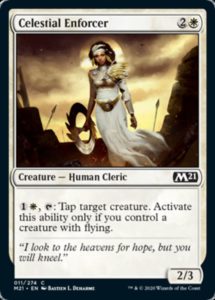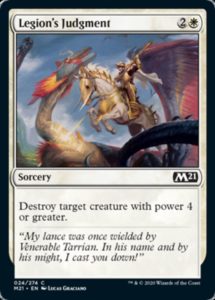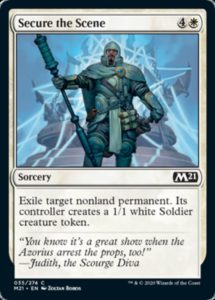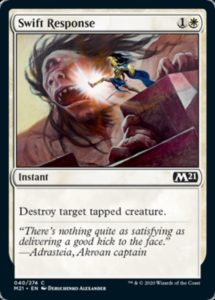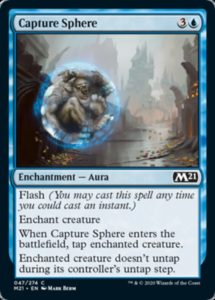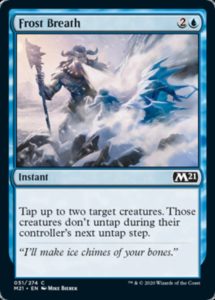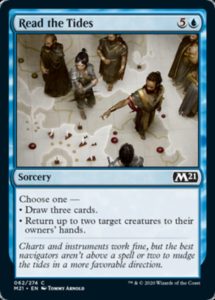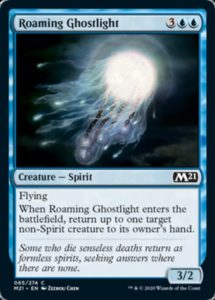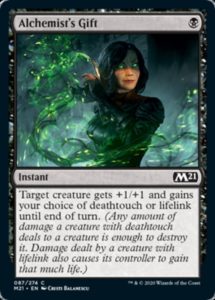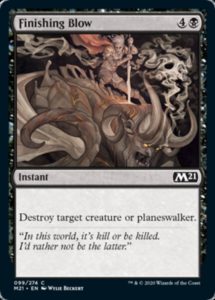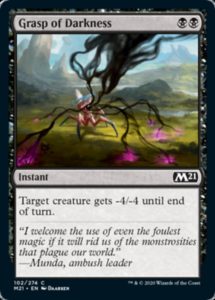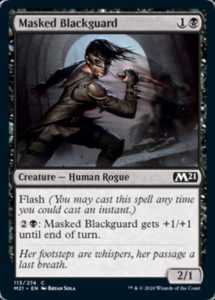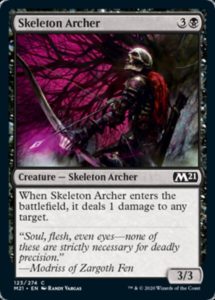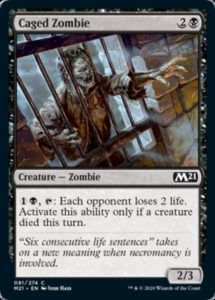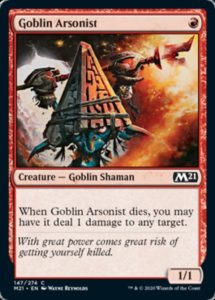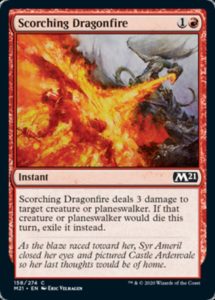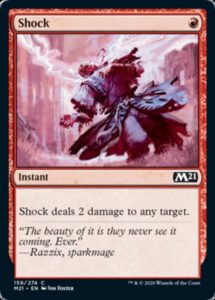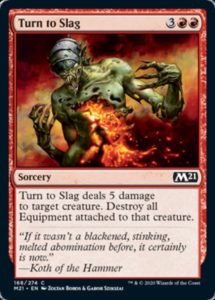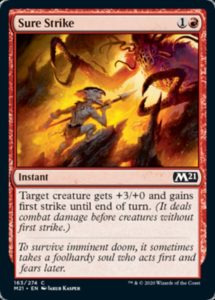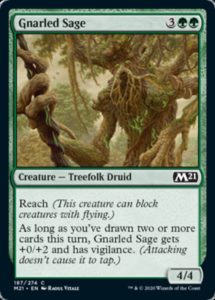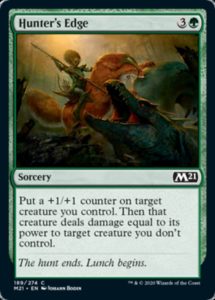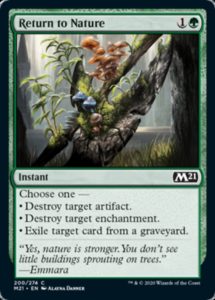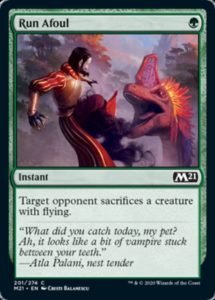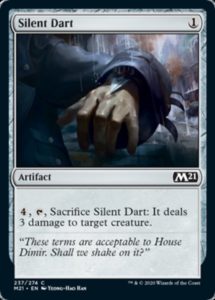Each Limited format is different, but there are principles that apply to each of them. Some are dependent on synergies while others are defined by generically powerful cards and looser themes. Some are defined by high-powered, high-rarity cards and others have plenty of potent commons. But perhaps the most reliable mechanism for evaluating Limited environments is removal. If a format has powerful, plentiful, and efficient removal at common, games can go longer and play slower. If a format’s common removal is weak, or its common creatures are powerful and inexpensive, then games are more often defined by tempo and aggression.
Today, we’ll examine all of the common removal in Core Set 2021 and get a glimpse into what this summer’s format will look like.
White
Law-Rune Enforcer is one of the best tappers we’ve seen in a while, combining a cheap and relatively useless set of stats with a mana-efficient tapping ability. Celestial Enforcer combines a mediocre but passable power and toughness with an expensive cost and added condition. The fail state of a 2/3 for three isn’t terrible, but it’s not exactly worth writing home about. If the format is defined by board stalls, then you’ll likely have excess mana for her to use and value the fliers she’ll need; but a lot needs to go right for this be more than a passable card.
Reprisal effects ebb and flow, but they generally suffer due to a dearth of common targets. This hits ten commons, which is about average (though better than it was in Legion’s Judgment‘s first printing when it only hit five unmodified creatures). Being a sorcery is a huge strike, since these effects shine when they can turn an opponent’s combat trick into an advantageous 2-for-1. I expect this to be sideboard material.
We’re long past the days where a five-mana unconditional removal spell is one of the best commons. Yes, Final Death was outstanding in Theros Beyond Death, but much of that was due to how slow the format was and how important exiling is against Escape cards. If you created the token, this would be a fine removal spell; but giving your opponent a small gift in addition to spending five mana is a hefty price to pay unless you’re killing their seven drop. And at sorcery speed, I’m not at all excited to play this.
Swift Response is perhaps the best common Take Vengeance we’ve ever seen. These effects tend to be defensive, since your opponent usually only has tapped creatures if they’re attacking (though this works against some activated abilities and can be combined with tappers). It’s white’s best common removal spell, but that’s not saying much. Yes, this will be good if you’re a defensive or skies white deck, but white lacks the proactive removal it needs to play aggressively.
Overall, white’s removal seems wanting. It seems to have invested more power in all-around powerful cards like Basri’s Acolyte, fragile threats like Dub, and card advantage in Valorous Steed than it has in its removal.
Blue
Generally fine but rarely excellent, Capture Sphere is a welcome pickup for most blue mages. It gets worse when creatures have potent abilities (which is rarely the case at common) or sacrifice effects (which is the BR theme), but it’s something you’ll be content playing multiple copies of. Unlike most instant-speed removal, you can’t use this to two-for-one an opponent that’s using a combat trick, an annoyance that comes up often enough, which is a consistent, small strike against the card.
Frost Breath is pure tempo removal. If you’re applying heavy pressure, this is effectively “destroy two target creatures.” The rest of the time, this is card disadvantage and best avoided. It’s nice when blue has access to these tools, even if most decks won’t want them. Blue’s common creatures don’t seem to support the archetype, but I’d be surprised if this weren’t a potent addition to a UR deck.
Six mana is a lot to pay for three cards and a whole lot of mana for Into the Void. In general, you’ll probably want this as a Thassa’s Bounty, but the second mode means that every now and then you can win the game out of nowhere.
Man-o’-War is an outstanding Magic card. Yes, it’s been a while since Wind Drake or Snapping Drake were good cards, but bouncing an opponent’s four or five drop creature and deploying your own is a huge tempo swing. While the rest of blue’s removal ebbs from fine to forgettable, Roaming Ghostlight ought to be blue’s best. Sure, you can overload on these effects, but you need to be incredible behind for a 3/2 flying and the temporary loss of your opponent’s most expensive or relevant creature to not be a big game swing.
I dislike this having the forgettable non-spirit clause on it, but it’s almost certainly there to keep you and your opponent from bouncing each other’s Roaming Ghostlights. Just be mindful that Tome Anima is a spirit—as is Spirit of Malevolence, but that at least has spirit in the name.
Overall, blue seems to be perhaps a bit above average in terms of removal. Sure, Roaming Ghostlight‘s not Callous Dismissal, but it still looks to be a stellar threat and tempo swing all in one.
Black
Coat with Venom was an incredibly potent combat trick. While Alchemist’s Gift is neither that nor the next Skullduggery, it is a fine and flexible combat trick that can play a variety of roles. This will not be a high draft pick, but it’s worth keeping all one mana combat tricks in mind, especially ones that can turn any creature in combat into a Bone Splinters.
Finishing Blow has the text you want and a mana cost that’s one higher than you’d like. You’ll play this, it’ll do what you want, but iyou’ll trade down on mana a large portion of the time.
It’s interesting that “or planeswalker” has become such common parlance on common cards, even in a core set that doesn’t have an uncommon planeswalker like Chandra, Novice Pyromancer. It makes sense to make this text ubiquitous when you want cards to hit planeswalkers but not players (or creatures), but I’m accustomed to more upside in my five mana removal that hitting a mythic rare card every now and then.
Grasp of Darkness is a weird card. If playing heavy black is easy, it’s an outstanding removal spell. When BB is a more serious restriction, this becomes a weaker Murder. But it’s probably black’s best removal spell: while it’s not splashable, it’s more likely to trade up on mana than down. I could be wrong—Finishing Blow‘s splashability could give it the edge—but Grasp is a card I’m looking forward to playing and picking highly.
Giving black flash allows it to have these weird cards that sometimes get to be Righteous Blow while otherwise mediocre threats. This isn’t good at being a removal spell or threat, but combine they provide ample utility. I don’t recommend picking this highly, but this could fill out your curve and become a serious threat if you ever get to—checks notes—nine mana? Okay, maybe not, but it’s still fine.
An extra point of damage isn’t much, but this can turn a chump attack into a trade and pick off the odd Daybreak Charger or Keen Glidemaster. Hill Giant hasn’t been good for a while, but keep Skeleton Archer in mind when blocking.
That’s it for black’s removal. Grasp of Darkness provides a solid reward for committing heavily to the color, but nothing here is particularly exciting. Black often gets an expensive, 6+ mana kill spell or a mediocre 3-4 mana spell like Tar Snare; this time Finishing Blow seems to combine them with the perfunctory five mana kill spell and cuts down on black’s total amount of removal. Thus far, removal seems a bit below par. While I know this is about to change with red, the format seems like it’s more likely to be defined by powerful creatures and synergy given how lackluster and conditional much of the removal is.
Before we move on to red, can we take a moment and look at this card? It seems like the card was designed, playtested, and then forgotten about when ordering artwork. When a creature is in midair in the artwork, it has Flying. When a creature is behind bars that clearly restrict its movement, it tends to have Defender. Instead, this has a Morbid ability that even the flavor text doesn’t seem to know how to justify. What is this thing? Why does it have the ability it does and why doesn’t it have the Defender the art so clearly communicates it has? These things happen, but man, on man, this is a weird one.
Red
Great artwork, mediocre sacrifice fodder, and that’s about it. Be wary of Goblin Arsonist when your opponent has the ability to sacrifice it. Feel free to exploit that interaction yourself, but this is not good removal on its own.
Scorching Dragonfire, however, is great removal. It kills most creatures, does so at instant speed, and even prevents it from dying to stop pesky Caged Zombie shenanigans. This is red’s best common removal spell and you’ll be happy to have every single one you can find.
It’s pretty rare for a set to have both a Shock and a Lightning Strike variant at the same rarity and speed. Shock still has plenty of targets (there are actually a bunch of strong-looking commons it kills), but Scorching Dragonfire‘s 50% increase in effectiveness should more than give it the edge over Shock despite its 100% increase in cost.
Red’s worst dedicated removal spell is still fine. Sometimes it’ll randomly kill a Short Sword or Malefic Scythe, which will feel amazing. Most of the time, you’ll be spending five mana to kill a 3-5 mana creature. Not great, but it does a fine job of ensuring that red can deal with all but the largest creatures.
Sure Strike is always annoyingly good. It lets creatures take down much stronger opponents in combat and can get in a good chunk of surprise damage when your opponent is at a low life total. As with all combat tricks, it isn’t a true removal spell, but it can fill out a deck. Frankly, I’m a bit surprised that Sure Strike is here alongside Shock and Scorching Dragonfire. Red has a lot of common, instant-speed removal options at common, and adding Sure Strike gives aggressive red decks a bit more oomph.
On paper, red has the best removal by far. It will struggle with high toughness creatures as always, but its removal is mana efficient, plentiful, and often instant-speed.
Green
Gnarled Sage isn’t a removal spell, but folks who remember M13 know just how potent Sentinel Spider was at shutting down your opponent’s offense. Gnarled Sage is almost definitely the weaker card, since extra toughness sometimes is generally worse than reach always (on a 4/4, anyway). It’s still an efficient threat and blocker and could be a stellar common.
Hunt the Weak is back and better than ever. Now, you can have your counter and attack with it, too! On a semi-crowded board, you often had to wait a turn to attack after hunting, since your damaged creature would trade down, but now you don’t have to. This is a serious upgrade and one that green mages will appreciate, especially since this is their only common removal spell.
There are a non-trivial number of artifact creatures, but not enough good ones to justify maindecking Return to Nature. This is a sideboard card through and through, and something you probably shouldn’t play in Quick Draft on Arena.
This is an especially mediocre sideboard card. It suggests, as Clip Wings did, that there may be indestructible or hexproof fliers that Constructed mages will need assistance with. But in Limited, edict effects are generally poor, since boards are flooded. This is an extra conditional edict that might kill your opponent’s best, only flier, or it might take down a 1/1 bird token. Sideboard cards like Plummet are excellent because they do a very specific task very effectively; Run Afoul doesn’t even do that.
Green will depend on a support color for removal while providing above rate creatures. This is about par for the course for green in a core set.
Colorless
Springjaw Trap is the latest artifact-based Lightning Bolt, but it was no means the first. While Silent Dart is actually playable, unlike Flamecast Wheel, this is appreciably worse than Scalding Cauldron—four mana a lot to hold up, especially when your opponent sees it coming, and it can’t hit your opponent. This could have more added utility because nonred, nonblue removal in M21 seems below par, but there also are scant synergies to make it more than the sum of its parts (as was the case for Scalding Cauldron). This is a card you’ll begrudgingly play at times, but it’s there for mages in desperate need of removal.
And that’s all the common removal (and interaction, a spider, and a confusing zombie) in Core Set 2021. Blue and red seem to be above average in what they’ve received, black a bit below average, green about normal with one good common kill spell, and white looks like it’s put more power into its creatures and higher rarity cards than its common removal. In a few days we’ll get to test these predictions and hopefully they’ll help you win your first Limited events, be they in person or online (as many of our only M21 events are likely to be). Have some fun this weekend, stay safe, and stay sane.
And, as always, thanks for reading.
—Zachary Barash is a New York City-based game designer and the commissioner of Team Draft League. He designs for Kingdom Death: Monster, has a Game Design MFA from the NYU Game Center, and does freelance gatame design. When the stars align, he streams Magic (but the stars align way less often than he’d like).

